Dublin is the capital and the largest city in Ireland. It is located in the province of Leinster.
Best time to travel:
Winter:
Temperatures are among 2 and 8ºC during January and February, due to the humidity. However, regarding the precipitations are fewer than in summer.
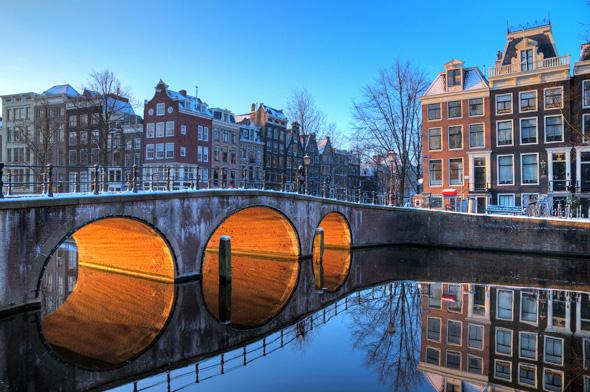
Summer:
Summers in Dublín are not too hot. Throughout July and August average temperatures go from 11ºC to 20ºC and due to the chances of precipitations, they make summers in Dublin be cool and pleasant.

Nevertheless, any time of the year is perfect to visit Dublin, even though the best time is in summer because days are longer and temperatures are nicer. It is important to take into account when travelling to Dublin that its weather is unpredictable, and even if the day begins to get lighter, it may rain a couple times during the whole day.

Transport:
Bus:
There are more than 100 bus lines in Dublin. An important detail you must take into account is to always pay the exact price and to take coins with you because bus drivers do not give the money back, they give you a ticket so that way you can go to Dublin Bus Offices to exchange the money in the ticket. Bus prices depend on the number of stops between the origin and the destinatio.
Adults
- From 1 to 3 stops: 2€.

- From 4 to 13 stops: 2,70€.
- More than 13 stops: 3,30€.
Under 16 years-old
- From 1 to 7 stops: 1,15€.
- More than 7 stops: 1,40€.
Timetable and frequency
It depends on every bus line. Buses operate from 7:00 to 23:30 hours.
Luas (Tram)
Red line
It connects Tallaght (southwest) with The Point (east). It has 32 stops and it is used to get to interesting places like the Jameson Distillery. The final destination is in O´Connell Street.
Green line
Connects Brides Glen (southeast) with St Stephens Green. This line has no touristic interest.
Dart:
DART (Dublin Area Rapid Transit) is a railway that runs all of Dublin’s coast, from Malahide and Howth towards the south. It is a wonderful way to visit all of the beautiful fishing grounds. Dart services start at 6:00 am till 23:30 pm from Monday to Friday with a 20 minutes aproximately frequency. Timetables are available at the majority of the train stations.
Dublin has three main train stations:
- Connolly Station.
- Tara Station.
- Pearse Station.
Map of the city:
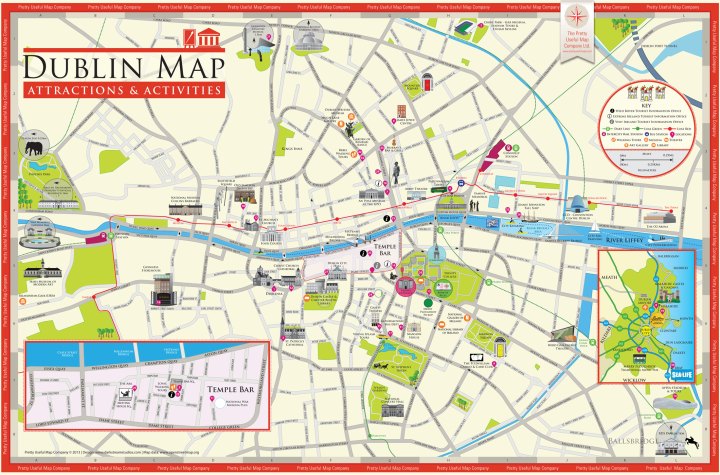
What to see in Dublin and outskirts?
- O’Connell Street: Is the main avenue, it is usually full of people. Some of the monuments along O’Connell Street are The Spire, a large, stainless steel, pin-like monument 119 metres in height, The GPO (General Post Office) is the headquarters of The Post. During the Easter Rising of 1916, the GPO served as the headquarters of the uprising’s leaders and nowadays it represents irish nationalism.
- Grafton streeet: It runs from Trinity College to St Stephen’s Green. Its is one of the principal shopping streets. Near Grafton Street there is the Moly Malone statue which is also known as «The Tart with the Cart» due to its history. A fishmonger who plied her trade on the streets of Dublin, she was a hawker by day and part-time prostitute by night.
- Henry Street: is one of the two principal shopping streets of Dublin, running from the Spire to Liffey Street.
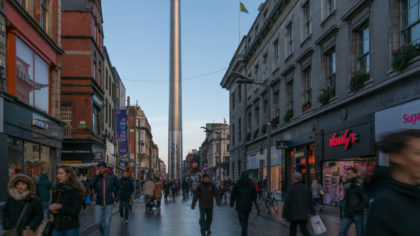
- Temple Bar: Legends say that in 1599, Sir William Temple, a teacher and philosopher,built his house and gardens on newly reclaimed land here on the corner of Temple Lane and the street called Temple Bar. In 1656, his son, Sir John Temple, acquired additional land. In the 17th century ‘Barr’ usually meant a raised estuary sandbank often used for walking on. Thus the river Liffey embankment alongside the Temple family’s plot became known as Temple’s Barr or simply Temple Bar. Later this evolved into the present thoroughfare connecting this whole area from Westmoreland Street to Fishamble Street. At night the area is a centre for nightlife, with various tourist-focused nightclubs, restaurants and bars. Pubs in the area include The Temple Bar Pub, The Porterhouse, the Quays Bar…
- Trinity College: The college was founded in 1592 by Queen Elizabeth I as the «mother» of a new university. Trinity College is considered to be the most prestigious university in Ireland. Historically, Trinity College was set up in part to consolidate the rule of the Tudor monarchy in Ireland, and as a result was the university of the Protestant Ascendancy. While Catholics were admitted from 1793 certain restrictions on membership of the college remained. The Library of Trinity College contains over 6.2 million printed volumes and significant quantities of manuscripts, including the Book of Kells which is an illuminated manuscript Gospel book in Latin, containing the four Gospels of the New Testament together with various prefatory texts and tables. Some people like Jonathan Swift, Oscar Wilde or Erwin Schrödinger studied in Trinity College.
- Guinness Storehouse: The Guinness Storehouse explains the history of Beer. The story is told through various interactive exhibition areas including ingredients, brewing, transport, cooperage, advertising and sponsorship.
- Custom House: The Custom House is a neoclassical 18th century building in Dublin, which houses the Department of Housing, Planning and Local Government. It is located on the north bank of the River Liffey, on Custom House Quay between Butt Bridge and Talbot Memorial Bridge.
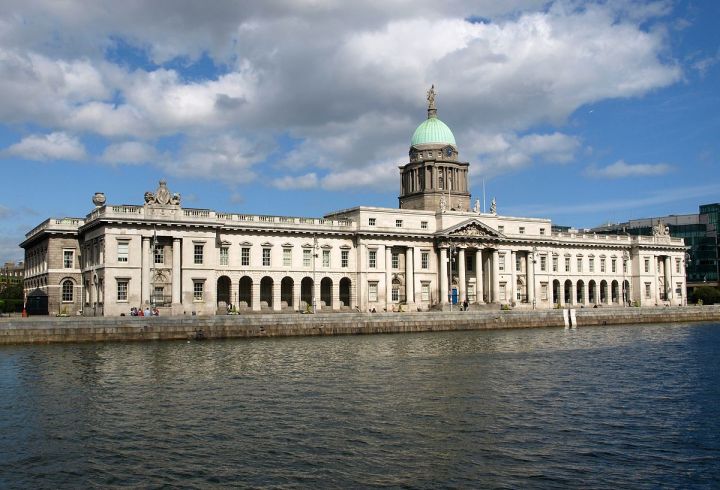
- Dublinia: is a historical recreation museum and visitor attraction in Dublin, focusing on the Viking and Medieval history of the city. Dublinia is located in a part of Dublin’s Christ Church Cathedral, known as the Synod hall. Dublinia features historical reenactment, with actors playing the roles of Vikings and Medieval Dubliners as it has recreations of Viking and Medieval era buildings and street scenes.
- Ha’penny Bridge: is a pedestrian bridge built in 1816 over the River Liffey. William Walsh fixed the ferries and the bridge, therefore, he decided to extract a ha’penny toll from anyone crossing it for 100 years.
- St. Patrick’s Cathedral: is the National Cathedral of the Church of Ireland. Designated as the local Cathedral of the diocese of Dublin. It is know because Jonathan Swift’s tomb is on the inside. The entry price is about 6 €.

- Christ Church Cathedral: Christ Church Cathedral or The Cathedral of the Holy Trinity, is situated in Dublin, and is the elder of the capital city’s two medieval cathedrals. It is know by its mummified cat and rat.

- Dublin Castle: was until 1922 the seat of the United Kingdom government’s administration in Ireland, and is now a major Irish government complex.

Important Parks to see:
- St. Stephen’s Green: St Stephen’s Green is a city centre public park, located next to Grafton Street, is the largest of the parks in Dublin.

- Merrion Square: is considered one of the city’s finest surviving squares. Merrion Square was a fashionable address for politicians, lawyers, doctors and writers as Edward Gibson, 1st Baron Ashbourne or Oscar Wilde.

- Iveagh Gardens: is a public park land it is designated as a National Historic Property. The gardens are almost completely surrounded by buildings making them less noticeable and a little hard to find, that is what makes them one of Dublin’s hidden gems.

- Phoenix Park: is one of the largest enclosed recreational spaces within any European capital city and it has been home to a herd of wild fallow deer. Dublin zoo, Papal cross, the Wellington Monument or the Deerfield residence are some of the most popular atractions to see. Not to mention the loose deer
- Powerscourt Estate: is located in Enniskerry, and is a large country estate which is noted for its house and landscaped gardens. It has italian gardens, japanese gardens, a pet cementery and a beautiful waterfall. The entry price is around 8€.
- Garden of Remembrance: It was open in 1966 to rcommemorate the Easter Rising. It is dedicated to all of those who died fighting for Ireland’s freedom and independence. It can be visited from April to September from 8:30 to 18:00 pm; and from October to March from 9:30 to 16:00 pm. Doors are decorated with celtic signs. At the bottom of the pond, we can see mosaics shaping viking weapons. They show the celtic tradition of throwing the weapons at the bottom of the river after a battle to celebrate that it was over.

What to see around Dublin?
- Howth, Malahide and Bray: Small villages near the east coast.
- Galway and The Cliffs of Moher: The Cliffs of Moher are sea cliffs located at the southwestern edge of Ireland. They run for about 14 kilometres and they rise 120 metres. They are located near Galway, a city in located at the west of Ireland.
Facts to take into account when travelling to Dublin:
- In Ireland it is needed a power adapter, its voltage is 240v.
- If you are a EU citizen, you will only need you ID or Passport.
- Dublin’s time line is (UTC ±0)
- Its national coin is the Euro.
- Its official languages are English and Irish. However, irish people are quite polite and nice and they are always willing to help if you need it.
- In Ireland, on March 17, Saint Patrick’s Day is celebrated. It is celebrated with big parades and by going to pubs.
Places to eat:
- The Church: It was built at the beginning of the 18th century, and it is now used as a restaurant and as a pub. At night there are usually traditional music shows and well as traditional dancing shows such as the céili.
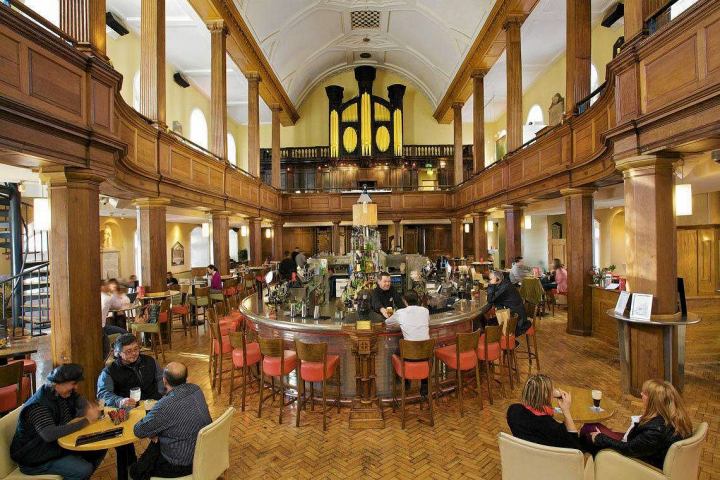
- Bobbo’s: is a neighbourhood diner, where you can get Real Gourmet Irish Burgers!








































